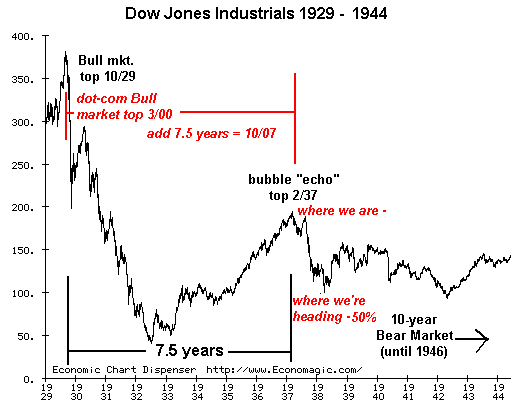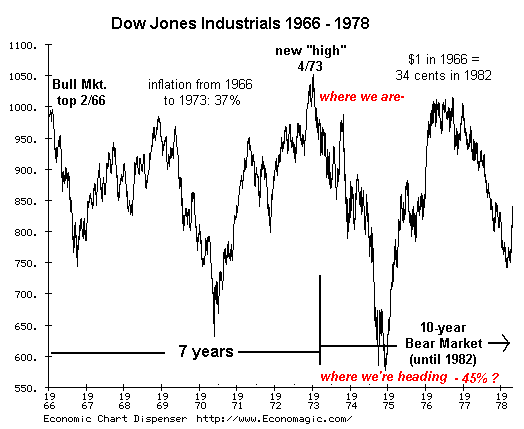

|
| weblog/wEssays archives | home | |
|
When "Buy on the Dips" Becomes a Pampers Moment (November 10, 2007) Longtime contributor U.K.C. sent in this timely quote from John Kenneth Galbraith's classic book The Great Crash 1929 A common feature of all these earlier troubles was that having happened, they were over. The worst was reasonably recognizable as such.Frequent contributor azvitt took this line from yesterday's post: The fear and distrust can no longer be papered over with more lies and prevarications. and commented: Considering the scale of this financial diarrhea, perhaps it might be said that it "can no longer be pampered over"? (Grin) OK, chart time. Here are two charts depicting the last two post-bubble "echo bubbles" which led to declines of around 45% - 50% in the Dow Jones Industrials. Looks like we're right there again. So when the markets "rally" and fail, and then "rally again," remember what these charts suggest: "echo bubbles" have historically fallen 40+%, not a meager 10%: 

Why would the market deflate 40% instead of only 10%? Here are a few reasons of many. 1. margin debt is at a high, and margin calls exacerbate any decline. Margin Debt Grows; Risk Grows Too (October 20, 2007, The Big Picture Blog/Barry Ritholtz) When the cash value of an account falls below 50%, the broker issues a margin call. The owner either has to pony up more cash to cover the call or sell stocks to raise the cash value of the account back over 50%. This has a very nasty corrollary: you have to sell $2 to raise $1 in cash. If you have a $100,000 account with $50,000 on margin, and the account falls to $90,000, then you will get a margin call of $10,000. To raise $10,000 in cash, you will have to sell $20,000 of stock. Margin calls have to be covered within three trading days. The decline kicked off in earnest on Wednesday, Nov. 7, so folks with margin calls will have to transfer cash into their accounts or sell stock/securities on Monday, Nov. 12 or Tuesday Nov. 13. Thursday's decline resulted in additional margin calls. In the past five years of debt-fueled "prosperity," in most cases the market Bulls "saved" those facing margin calls by engineering rallies after every one or two-day decline. But now it seems the era of miraculous "last hour rallies" may have drawn to a close. More margin calls are being issued at the close of every day. Next week, the margin chickens come home to roost. As selling generates more margin calls, then those with huge margin calls must sell, accelerating the decline, which then forms a negative feedback loop of great power: more selling begets more margin calls which beget more selling. 2. the yen carry trade is toast. The yen carry trade (borrowing in yen and investing dollars in U.S. stocks and bonds) has been one of the fundamental supports of the U.S. market's five year rally. Now that the dollar is collapsing, foreign exchange money is flowing into the yen, strengthening that currency to the 110 level. Although I am not an expert in this trade, there seems to be a "line in the sand" around 115; below that, the trade gets riskier and traders "unwind" their trades by selling U.S. stocks and converting the dollars back into yen. Combine the unwinding of the carry trade with margin calls, throw in the loss of confidence in the dollar, the Fed and the U.S. financial markets and bankers, and you have sufficient ingredients to bring about a 40% decline. I know, I know--that isn't possible. The Fed will save us, or Hank Paulson's Plunge Protection Team, or some sudden splash of "good news" engineered by the lapdogs of the financial media. As many others have noted, the Fed can't cut the Fed Funds Rate any further without risking a global currency crisis. Frequent contributor U. Doran sent in the very important story that French President Sarkosy (who is generally pro-American) is warning Bernanke & Co. not to try to "save" the U.S. by devaluing the dollar: Sarkozy fears 'economic war’ as dollar slides The French president, Nicolas Sarkozy, has warned the United States Congress that the US risks triggering "economic war" if it attempts to devalue its way out of trouble by allowing a relentless slide in the dollar.(Note that this important story received virtually no coverage in the U.S.-based mainstream or financial media. This reflects the hubris and arrogance at the very heart of U.S. financial markets and policies.) Before you count on all those wonderful, warm and fuzzy fantasies of being saved by yet another miraculous Bull Rally, recall that $3 trillion trades on the forex each and every day. Even if central banks intervene to the tune of tens of billions of dollars, trying to weaken the yen and prop up the dollar, the juiced rally will only last as long as the intervention. Perhaps the moment has finally arrived when all the men (and a very few women) behind the curtains, furiously pulling their levers to control the markets, may find their levers have limits. Readers Journal updated 11/09/07 More new entries-- Please see top-right sidebar for this month's essays. Thank you, Sourav G. ($10) for your generous contribution to this humble site. I am greatly honored by your readership and support. All contributors are listed below in acknowledgement of my gratitude. For more on this subject and a wide array of other topics, please visit my weblog. copyright © 2007 Charles Hugh Smith. All rights reserved in all media. I would be honored if you linked this wEssay to your site, or printed a copy for your own use. |
||
| weblog/wEssays | home |